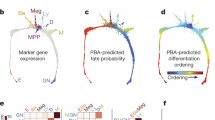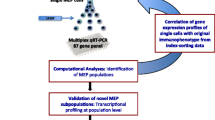Abstract
The human promyeloid cell line H60 can be induced to differentiate towards either neutrophils or monocytes. Variant cell lines, derived from HL60, which show reduced capacities for neutrophil and monocyte differentiation can be arranged in a developmental sequence which suggests that the potentials for neutrophil and monocyte differentiation are expressed sequentially by HL60 cells in this order. Analysis of the patterns of total cellular phosphoproteins within HL60 and 5 variant cell lines, by two-dimensional gel electrophoresis, has identified 6 distinct phosphoproteins which show progressive differences in the intensity of spots between the variant lines. The changes in these phosphoproteins relate to the position of the lines within the proposed development sequence. Similarly, lines placed close together in the sequence are more similar, as regards phosphoprotein profiles, than lines placed far apart. These studies provide direct evidence in favour of the hypothesis that the potentials for neutrophil and monocyte differentiation are expressed sequentially during myelopoiesis. Furthermore, two phosphoprotein spots were found to be restricted to lines able to differentiate towards monocytes. These proteins may play important roles during commitment to monocyte differentiation.
Similar content being viewed by others
Author information
Authors and Affiliations
Rights and permissions
About this article
Cite this article
Bunce, C., Lord, J., Wong, AY. et al. Near neighbour analysis of variant cell lines derived from the promyeloid cell line HL60. Br J Cancer 57, 559–563 (1988). https://doi.org/10.1038/bjc.1988.128
Issue Date:
DOI: https://doi.org/10.1038/bjc.1988.128
- Springer Nature Limited




